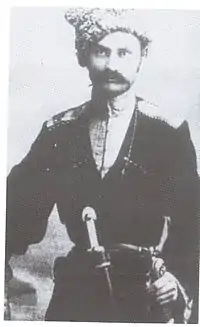Ivan Sorokin
Ivan Lukich Sorokin (4 December 1884 - 3 November 1918) was a Russian military leader, participant in the Russo-Japanese, World War I, and Civil Wars. Commander-in-Chief of the Red Army of the North Caucasus. Commander of the 11th Red Army.

Working his way up through the ranks, he eventually received a commission.[1] Sorokin arranged the execution of his rival commander, Ivan Matveyev on 7 October 1918. Following the execution, Sorokin established a reign of terror that demoralized the Red armies in the North Caucasus, which caused him to be declared a traitor on 27 October. He was subsequently assassinated on 2 November.[2]
Biography
Early life and education
A cossack from the Kuban region, Sorokin graduated from the Yekaterinodar military paramedic school. He became a member of the Socialist Revolutionary Party in April 1917.
First World War
During the First World War he served in the 1st Labinsk Regiment of the Caucasian Front as a paramedic. In 1915, he was sent to the Tiflis ensign school, after which in 1916 he was promoted to the rank of "corral" (xору́нжий) .
From 1916 and 1917, Sorokin served in the 3rd Linear Regiment. In 1917 he was promoted and was awarded the St. George Cross of the 3rd and 4th degree.
Civil War
In early 1918 he organized the first Red Cossack detachment in the Kuban.
Since February 1918 - assistant commander of the Southeast Red Army.
During the First Kuban campaign of the Volunteer Army (February 9 [22] - April 30 [May 13] 1918) he actually led all the opposing Soviet forces in the Kuban Soviet Republic A.I. Avtonomov.
In April-May 1918, he supported the Commander-in-Chief of the North Caucasian Red Army A.I. Avtonomov in his conflict with the civilian authorities of the Kuban-Black Sea Republic. Soon after the removal of Avtonomov because of this conflict and the appointment of K.I. Kalnin in his place, July 21 (August 4) 1918 replaced the latter, after the defeat of the Reds by the Volunteer Army near Tikhoretskaya and Kushchevskaya (Second Kuban campaign), as commander of the Red Army North Caucasus.
By order of the headquarters of the North Caucasus Military District on September 24, 1918, Sorokin was approved as commander in chief of the North Caucasus troops.
Sorokin’s army was 30–40 thousand soldiers of the former Caucasian front with 80–90 guns and 2 armored trains, located in the Kushchevka-Sosyka area and had two fronts:
North against the Germans; Northeast against the Don and Volunteer armies. In October 1918 -he became commander of the 11th Red Army.
References
- "Sorokin, Ivan Lukich". TheFreeDictionary.com. Retrieved 2019-11-03.
- Peter Kenez, Red Attack, White Resistance, p. 188.